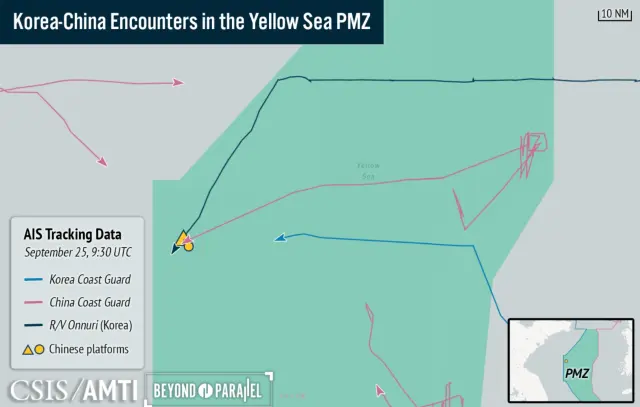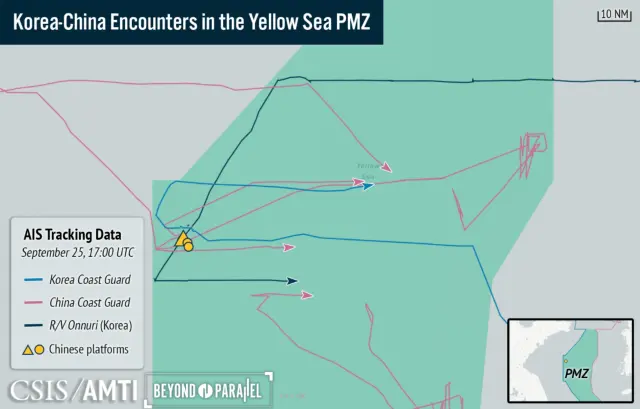-
Student Loan Delinquencies Surge to Alarming Levels—Credit Score Report - 20 mins ago
-
Not All Targeted Killings Are the Same. Hegseth’s Boat Strikes Are Illegal. - 42 mins ago
-
Congress Rewrites Hemp Definition, Reshaping Cannabis Rules - 55 mins ago
-
Pacific Palisades residents preserve community with block party - about 1 hour ago
-
Your Gift Dilemmas, Solved - about 1 hour ago
-
Woman’s Gift for Best Friend 25 Years in the Making Has Strangers in Tears - 2 hours ago
-
Online child safety advocates urge California to increase protections - 2 hours ago
-
Judge Blocks Access to James Comey Emails on Lawyer’s Seized Computer - 2 hours ago
-
Hollywood Doesn’t Want Netflix to Buy Warner Bros. - 2 hours ago
-
Elizabeth Holmes is apparently angling for a Trump pardon - 3 hours ago
Map Shows Standoff Between China and US Ally in Disputed Waters
Ship-tracking data indicates that a standoff at sea between China and South Korea, a key United States treaty ally, reportedly occurred in disputed waters in late September.
The incident took place near a U.S. military base in Pyeongtaek, South Korea, Yonhap News Agency reported. South Korean Foreign Minister Cho Hyun said Washington is taking it seriously, and Seoul will review how to cooperate with its ally on the issue.
The Chinese Foreign Ministry did not immediately respond to a request for comment.
Why It Matters
Under a 2000 agreement, China and South Korea created the Provisional Measures Zone (PMZ) in the Yellow Sea, where their 230-mile-wide exclusive economic zones (EEZs) overlap, pending a final maritime boundary settlement between the two nations.
China has expanded its presence in the jointly managed PMZ by installing aquaculture structures. While such moves are not clearly prohibited under the agreement, they were contested by South Korea for a lack of prior consultation before their deployment.
Meanwhile, China has maintained a strong naval presence in the PMZ and in waters considered part of South Korea’s EEZ, raising concerns in South Korea, which hosts 28,500 U.S. troops, over China’s attempts to gather military intelligence on the allies.
What To Know
Citing Automatic Identification System data, which tracks the position of ships, from Starboard Maritime Intelligence, the Center for Strategic and International Studies’ Asia Maritime Transparency Initiative reported the maritime standoff on Monday.
According to the report, the South Korean research vessel Onnuri entered the PMZ on September 24 and was later shadowed by a Chinese coast guard patrol ship with hull number 6307. Two additional Chinese patrol vessels also were deployed to the area.

Meanwhile, the South Korean coast guard dispatched a vessel with hull number 3009 to support the Onnuri. The next day, when both South Korean ships sailed toward two Chinese aquaculture structures, they were closely watched by the Chinese coast guard.
A map provided by the Asia Maritime Transparency Initiative shows that each South Korean vessel was trailed by two Chinese ships after passing at close range near the Chinese structures. The shadowing stopped once both had departed the PMZ eastward.
A similar standoff occurred in February; however, the latest incident highlights the ongoing pattern of what the Asia Maritime Transparency Initiative called “deliberate presence and surveillance” near China’s unilaterally deployed platforms in the PMZ.
China’s attempts to restrict the navigation of South Korean vessels in the PMZ clearly violate the United Nations Convention on the Law of the Sea (UNCLOS), the report said, under which all foreign vessels enjoy freedom of navigation within the EEZ.

The report noted that China’s tactics in the PMZ resemble those the East Asian power has used in the contested East China Sea and South China Sea, where an overwhelming and persistent Chinese coast guard presence asserts control over disputed waters.
What People Are Saying
The Asia Maritime Transparency Initiative of the Center for Strategic and International Studies wrote in a report on Monday: “While China’s use of its coast guard to patrol the perimeter of the PMZ and carefully shadow Korean government and research vessels in the area does not technically violate the terms of the agreement or of [United Nations Convention on the Law of the Sea], it resembles gray zone tactics that Beijing has employed in the South and East China Seas to use overwhelming and persistent coast guard presence to assert control over disputed areas.”
China’s Foreign Ministry said following a meeting between Chinese and South Korean officials in April: “The two sides also agreed to enhance mutual trust and strive to make the Yellow Sea into a sea of peace, friendship and cooperation, while jointly promoting the continuous development of the China-[Republic of Korea] strategic cooperative partnership.”
What Happens Next
It remains to be seen how South Korea can further bolster its maritime presence in the PMZ through either naval or coast guard deployments to counter Chinese activity.
Source link





















